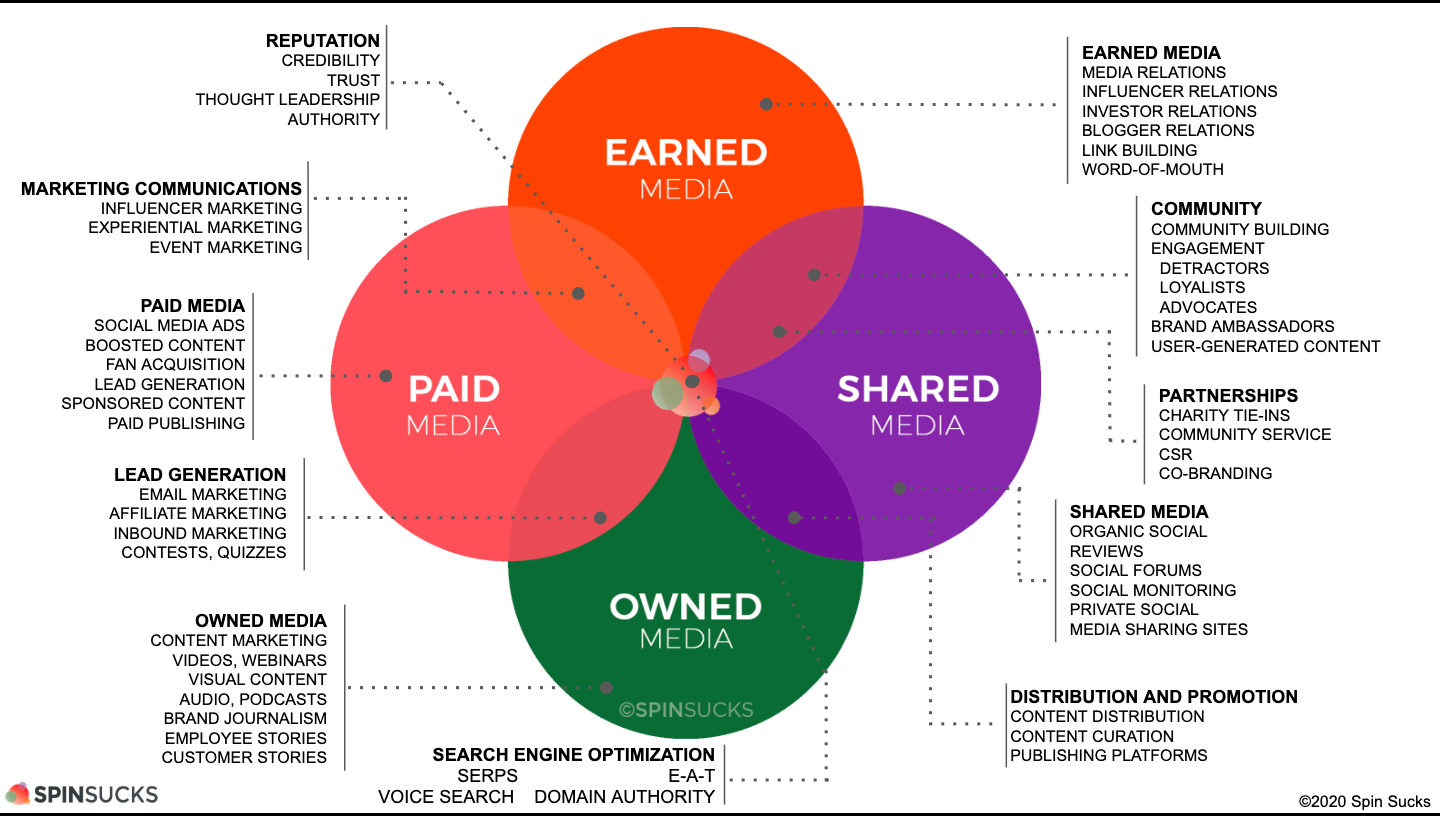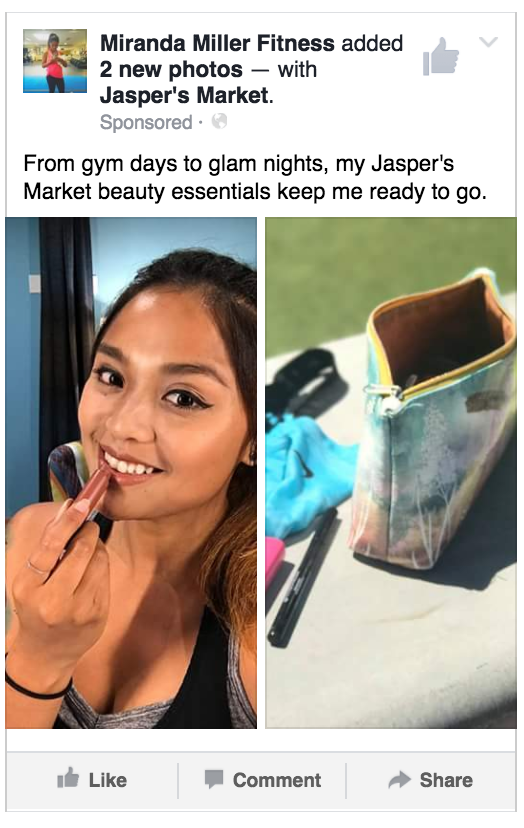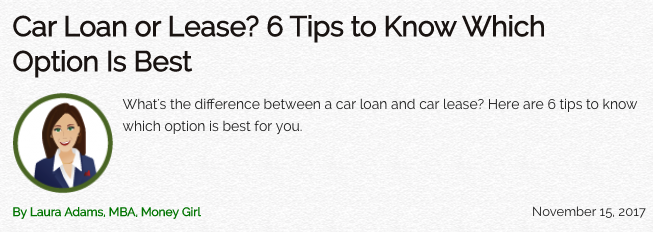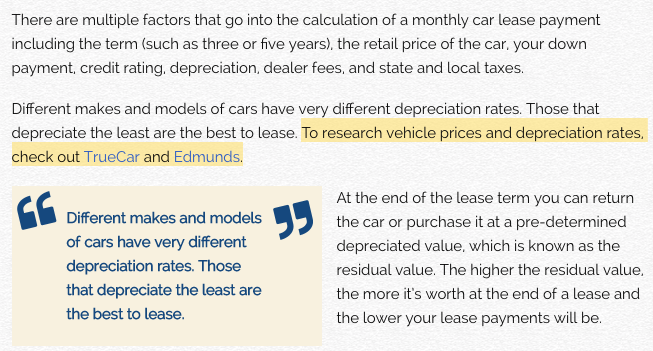
If you’ve been following the Spin Sucks PESO Model series so far, you know a thing or two about why the integration of all four media types—paid, earned, shared, and owned—is crucial.
And whether or not you’ve formally implemented the technique, chances are you’re already using it as part of your overall strategy as an online marketer.
As a refresher, PESO stands for Paid, Earned, Shared, and Owned media. It refers to the four main channel groups of any integrated marketing program.
For example:
- Paid media includes advertisements you pay for, such as banner ads and Google AdWords.
- Earned media includes marketing you earn through relationships, such as press coverage, blogger reviews, and influencer marketing.
- Shared media includes content shared by your customers and the public, such as social media mentions, customer referrals, and online reviews.
- Owned media includes assets you own end-to-end, such as your website and blog content.
As you can see in the graphic, there are ways that each of these channels overlap with each other.
For instance, you might pay influencers, but they generate engagement for you through social media.
Similarly, you pay for affiliate marketing. However, the influencers are more like owned media than earned media since they are willing to play by your rules, whereas journalists don’t have to.
A smart marketing program leverages and uses all of these channels individually.
A smarter one thinks of how they extend the efforts of each channel to amplify results across their entire PESO strategy.
Expanding Affiliate Marketing Across the PESO Model
One key area where marketers often miss the mark is with affiliate marketing.
Many marketers find their affiliates, ramp them up, and then switch to autopilot, letting the affiliate do their thing with nary an email featuring top tips to boost referrals.
They forget that affiliates are not marketers. They don’t have the same marketing knowledge you do.
If you arm them with that knowledge and begin to integrate them into all of the other content and engagement you’re building as part of your larger PESO model, you’ll open up a faucet that drives a ton of referrals your way.
You’ll have a very happy affiliate and a very impressed boss.
Keep reading to discover how you can work affiliate marketing into each segment of your PESO strategy.
Paid Media
One quick caveat on paid media and affiliate marketing: you probably do not want to allow your affiliates to bid on your brand terms with advertising.
This will only drive up the bidding price for yourself.
However, there are ways you can boost your affiliate marketing efforts through paid media.
Consumers are getting better than ever at ignoring branded ads on- and off-line.
You know this—it’s probably at least partly why you started an affiliate marketing program in the first place.
Fortunately, new strategies like influencer marketing are delivering up to 11 times the ROI of display ads and other digital marketing.
If you can find relevant influencers to promote your brand on social media, why not give their posts a digital hand up through paid social?
Because the post is coming from your affiliate, instead of your brand, it’s much less likely to be ignored. Facebook enables brands to boost posts from their influencers.
These are sponsored posts, but they look like a post from a friend instead of an ad:

Coupon Affiliates
Running ads on your affiliate’s Twitter and Facebook posts helps you reach more fans on social media.
Significantly expand your reach on the rest of the internet by promoting deals or promo codes on coupon affiliate websites.
Price-savvy customers often search for queries like “[your brand] + coupons” and “[your industry] + coupons.”
They find what they’re looking for on coupon sites.
Most coupon affiliate sites partner with networks such as Commission Junction and Shareasale to connect them with brands, allowing them to easily track conversions and monitor payments.
These websites work on a CPA basis so you pay per conversion, just like with your one-to-one affiliate partnerships.
But the added value these websites offer is the keywords they’ve conquered.
These sites dominate the organic and paid landscape for discount-based searches, especially in regards to category or industry.
If you want to reach more online searchers who haven’t even heard of you yet and are looking for the best deal in your industry, coupon websites can introduce them to your brand in a highly persuasive way.
One thing to be wary of, however, is the types of coupon sites you’re working with.
Make sure they’re earning commissions fairly (some coupon sites hack search algorithms to get more clicks, but list invalid or spam codes), and double check traffic sources to make sure the coupon affiliate site you’re working with is a good one.
Earned Media
Your earned media is a great source for finding affiliates in the first place.
Which bloggers are already writing about your brand? Which social influencers are tweeting or Instagramming about you? Are you friendly with any online publishers?
Each one of these can become an affiliate. These people are already talking positively about you and wield influence online.
Imagine what can happen if you pair that influence with an exclusive promo code or discount for your brand.
Always be monitoring positive mentions of your brand name so you can form relationships with these folks and turn them into affiliate marketing partners.
For your customer-turned-affiliates, consider how you can turn their stories into conversion optimizers.
You might feature testimonials on a carousel on your homepage or product pages to increase your conversion rates, or develop a longer whitepaper or video case study.
While affiliates won’t earn money as a result of this placement, they are likely to enjoy the shoutout on your website, especially if you make it worthwhile for them with a backlink.
Shared Media
Are your affiliates solely promoting your brand on their own website? If so, they’re seriously limiting themselves.
Encourage your affiliates to actively share and promote their promo codes for your site across their social media channels.
Have them film live videos of themselves using your product with a link to their affiliate page in the description.
Recommend they use live videos if possible, since most social platforms tend to give live content extra priority in the main feeds.
Collaborate with your larger affiliates on themed contests.
The affiliate can share their promo code with everyone who participates, but only one lucky winner will receive a free product gift pack, yearlong subscription, or another especially tantalizing offer from your brand.
For example, after posting a video where he showed how easy it was for him to learn a new skill using Lynda.com, YouTube vlogger Jack Douglass invited his subscribers to do the same and tell him about it.
He featured his favorites in a follow-up video, driving both positive social engagement and tons of conversions for Lynda.com.
You can also introduce your affiliate to coupon forums.
While you’re managing relationships with larger coupon websites, allow them to spread the word in niche communities such as the coupons subreddit and Slickdeals.
Owned Media
Your successful affiliates already know some SEO, whether they realize it or not.
It’s what helps their sites to rank well and to drive that sweet, sweet affiliate traffic your way.
Share your SEO expertise so they can capture more organic traffic.
Google is extremely unlikely to grant your SEO fantasy of only ranking your website in the SERPs for your top keywords.
But by partnering with affiliates, you can ensure more of those page one results eventually funnel customers towards you—instead of your competitors.
Be strategic about which keywords your affiliates can help you out with most.
What terms could they rank for that your brand might not get away with as easily?
For example, while both their site and yours could rank for a “[your brand] vs. [your competitor]” comparison review, consumers are more likely to believe a third-party than you.
As such, they’ll probably click on your affiliate’s site and not yours, but as long as they send customers your way via their unique link, it’s all good.
As mentioned before, another keyword that coupon affiliate sites can rank for is “[your brand] + coupons.”
Work with these sites to create a dedicated coupon page on their site that features coupons for your brand.
Recommend they beef it up with contextual content to improve the page’s chances of ranking. Include a review, standout product features, and perhaps a personal testimonial of how your brand has uniquely helped them.
The Bigger Content Picture
Review each affiliate’s larger content strategy as well. Which posts would be a good fit to insert your affiliate link?
For instance, financial advice podcaster Laura Adams has an affiliate relationship with both Edmunds and TrueCar.
People who are buying cars typically want financial advice, so there’s a nice overlap in their target audience.
Laura doesn’t just rely on website banners to grab her visitor’s attention. She also writes supporting articles that attract Google searchers looking for information on buying a car.
In her post breaking down car loans vs. leases, she provides contextual links to both TrueCar and Edmunds so readers can learn more.


Besides SEO, another area where you can assist your affiliate is by helping them optimize their website for conversion.
Are they placing your affiliate banners in the optimal spots? Could they improve the anchor text of their internal links? How do their CTAs look?
Affiliates Marketing: Much More than Paid Media
It’s time to stop viewing your affiliates as solely a paid channel.
Consider how you can expand their efforts across your PESO strategy.
With affiliates, their win is your win.
So help them win more by sharing your marketing knowledge.
Watch the Spin Sucks PESO 2.0 Masterclass for FREE and learn how to implement the PESO model to achieve unparalleled communications results.